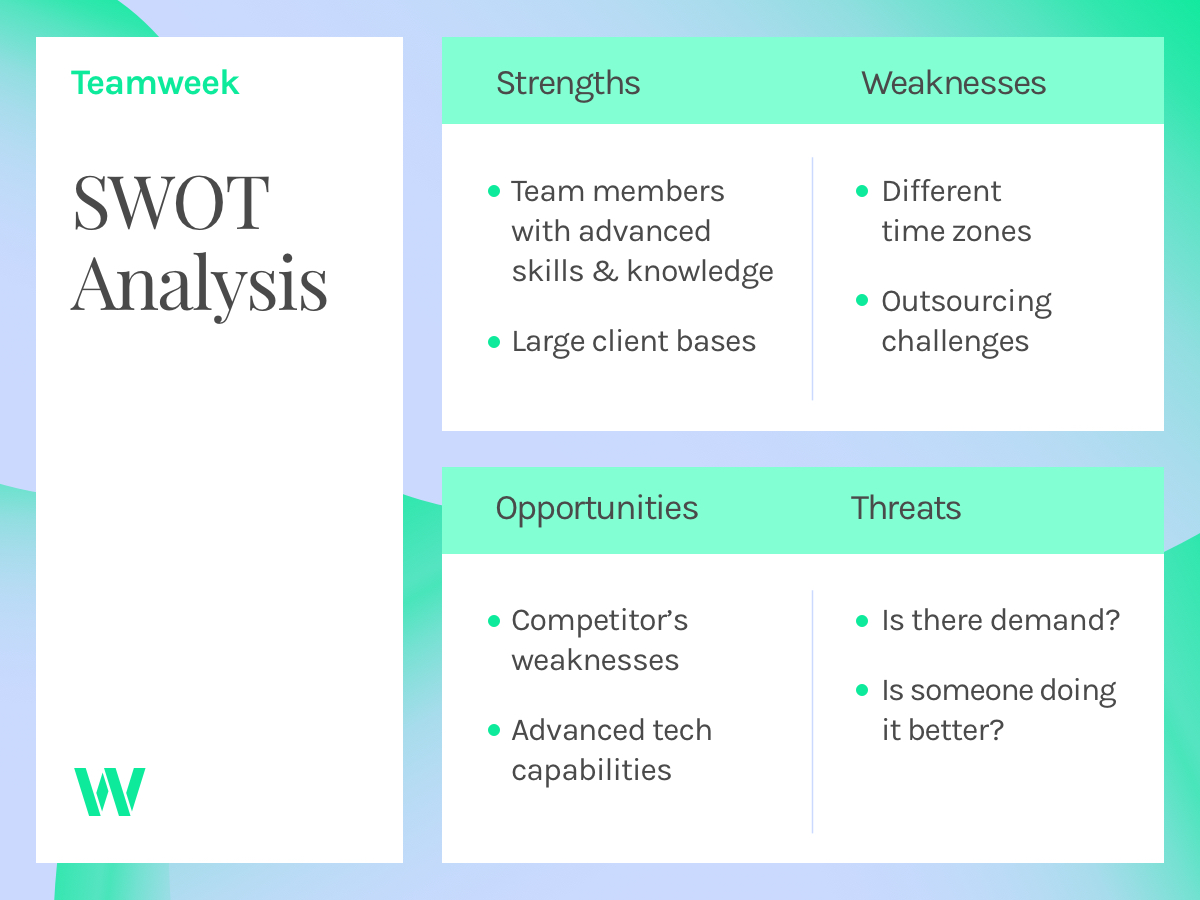SWOT. It sounds like something you’d do to a fly. Despite the onomatopoeia, this isn’t the case.
What is SWOT? SWOT stands for strengths, weaknesses, opportunities, and threats. The concept is simple: In a SWOT analysis you try highlight areas of a project that can make it more successful. Then you look at aspects of the project that can be potentially harmful. It sounds rather boring, doesn’t it? Actually, using the SWOT analysis in project management is quite effective and forces teams to think outside of the box.
SWOT Analysis in Project Management
As stated before, the concept is pretty simple. There are lots of templates and designs out there for SWOT analysis, but basically it involves setting up or drawing a 2×2 square. In these four squares, the principles of SWOT are displayed. Each square represents a different aspect of the project. This is best done as a group so that everyone’s voice is heard. Here’s an example:

SWOT analysis in project management can definitely get lengthy and more detailed, but you get the gist. You can also see what we mean by thinking outside of the box. Multiple viewpoints and ideas can aid in the progression of your SWOT matrix.
Strengths
Most people find it easy to brag, but it’s important to be honest and realistic in this category. Put your heads together and come up with reasons why your team is the best fit for the project. That’s not to say that you shouldn’t brag a little if you’re confident in your team’s abilities. Again, be honest!
Weaknesses
Everyone has their Achilles’ heel. The important thing here is to find it, address it, and focus on making it better. Whether it’s an individual or the team as a whole, you’re all in this together! It’s better to be aware of potential weaknesses than to be caught off guard when one of your team weaknesses becomes obvious.
Opportunities
Just like Harry Potter with his ticket to Hogwarts, we oftentimes find opportunities in the strangest places. Here is where ideas and strategies come into play. New technology advancements? Use them to your advantage. Are other business’ reviews showing potential weak points? Utilize that O in SWOT and find a way to do it better. Use those noggins.
Threats
Yes, threats. Let’s face it, no one is invincible and everyone has enemies (real or inanimate). Identify these threats and take them down. Address them, but make sure that your timeline and goals are still relevant.

SWOT Analysis for Project Managers: How to Present to Your Team
Come up with a matrix, define a few clear, valid questions, and see how it plays out.
- Who are our competitors?
- How can we do it differently?
- What’s our motivation?
- How soon can it be done?
These are just a few examples, but you can understand how these can help get the creative juices flowing. Make your list as long or as short as you see fit. Add and take away as time progresses. It’s all about your team and how your project can stand apart from the rest. Here are some quick points to consider:
- Focus on the purpose of the matrix. Make it simple and easy to understand. Your team should be able to read the points quickly and understand what they mean.
- Don’t be afraid to talk about weaknesses and threats, plain and simple. The point of this is to strategize. If one team member isn’t so fluent with a program, have someone who is use it. Utilize your team!
- Print out the matrix and hand it out. Have it as a reference, email it, whatever you have to do to remind your team of the purpose of the project in the first place.

How to Categorize SWOT Analysis Data
This is a pretty straightforward concept. All the good data and positive points should be under strengths and opportunities while the bad or negative points should fall under threats and weaknesses. Again, the point of this whole thing is to visualize the big picture. It’s about getting a bird’s-eye-view and exposing things that you may not have noticed before. It’s a great exercise for teams in general, but especially when working on a specific project. Let’s dive a little deeper. Here is a good outline:
Strengths: Here’s where all of the positive reinforcement and complimenting each other comes into play. Talk about the reasons your team can succeed.
- Team strengths – What are we good at?
- Competitive upper hand – Why are we better than the competition?
Weaknesses: Ugh, right? Not necessarily. These are factors that could potentially harm the project, so you’ll want to get them out in the open.
- Team weaknesses – Where can we improve?
- Competitive weaknesses – Where/why/how are other businesses doing it better?
Opportunities: Anything can be considered an opportunity. Name some potential sources, resources, contacts, or anything you can think of to aid your team in success.
- Current opportunities – Display your current opportunities. Whatever your team is benefitting from at the moment.
- Future opportunities – Opportunities that aren’t quite there yet, but you can see just on the horizon.
Threats: Yikes! The purpose of this one is to recognize what everyone thinks could be or currently is a threat. Anything that can harm and/or dissolve your project should be listed here.
- Current threats – Whatever is currently preventing the team from getting it done.
- Future threats – Whatever you think could be a problem later down the road.

The Takeaway
Pretty simple, huh? We think so. Laying it all out on the line like this is a fast, easy, and effective way to visualize the main goal of your project. With all of the bells and whistles of software nowadays, it’s sort of nice to just take a simple notepad or even an email to bring the team together and brief a project. The SWOT analysis combined with a powerful project management tool is a proven effective tool for project managers around the world, whether they’re in remote teams or together in an office.
We hope this helps you better understand the benefits of SWOT analysis and what this simple tool can do for your team. Now go out there and start brainstorming!
Like many other people, Zach McDaniel gained his knowledge of management and project management through research and necessity. He believes that the most interesting thing about project management, management, and productivity is that there are so many different strategies, so there’s always something new to learn and share.

